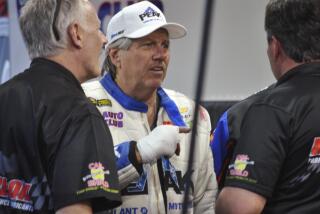Thrill Rides’ G-Forces Also Being Felt in Court
- Share via
There is no other thrill quite like it. Nothing that plummets you, hurtles you, twists you and turns you at the speeds and dizzying heights of the newest generation of roller coasters.
Amusement park engineers design the swings, flips and drops to create the illusion of risk. But as rides have become bigger, faster and scarier, doctors, regulators and lawyers are saying the danger isn’t imaginary.
Even as millions flock to parks this weekend for the start of tourism season, critics of the rides contend that thrill-seekers’ brains are being rattled around in their skulls, causing brain bleeds and tears that can result in permanent damage or death.
This fall, New Jersey is expected to set the nation’s first legal limits on the gravitational force that amusement park rides can produce. Industry officials, too, are moving to set new standards, although they say many of the people who have suffered injuries so far had preexisting health conditions, such as aneurysms.
Over the past several years, claims of brain injury from roller coasters have increased, according to policymakers and doctors.
Some who say they’ve been injured allege that the industry downplays an important risk. “At least when you are smoking, the cigarette [package] says you can get lung cancer,” said Zipora Jacob, 49, a former genetics researcher who settled a lawsuit with Disneyland after alleging she suffered a brain hemorrhage on the Indiana Jones Adventure ride.
“When I went on that ride, nobody told me that I could have a brain injury. People should know. They have to beware that it’s risky.”
Industry representatives accuse plaintiffs’ lawyers and regulators of hyping a small number of cases. They say roller coasters are safer than many forms of family entertainment, such as soccer on the weekends.
“If someone can find an activity that 320 million people do each summer that has less incidents, I’d really like to see what it is,” said Gary Story, president of Six Flags Inc., which operates 38 amusement parks worldwide.
Doctors and regulators examining the rash of claims are focusing on G-force, or the force of gravity, on roller coasters. The G-force can be measured by direction: up and down, forward and backward, or left to right. Of concern is how long the forces last and how quickly and radically they change, and whether the ride jolts back and forth abruptly, or suddenly speeds up or slows down.
One G-force equals the normal tug of gravity on the body. Two G-forces make a person feel twice as heavy as normal. As the G-force increases, it becomes harder for the heart to pump blood to the brain.
Zero G is weightlessness--the sensation of floating--and negative G gives the sensation of being pulled upward out of the seat.
Coaster enthusiasts’ Web sites show that the 10 fastest coasters have been built in the past eight years. The record holder, Dondonpa in Japan, opened in December and travels 106.9 mph.
Combining Speeds and Twists Increases G-Force
In 1994, roller coaster top speeds were 80 mph. Records for height, drop and angle of descent have also been shattered in the past several years. This year, Magic Mountain debuted X, a coaster whose cars can spin forward and backward 360 degrees. Combining speed and twisting tends to increase G-force, said ride engineer Steve Elliott.
Although NASA has researched G-forces, those studies have not measured the kinds of forces that roller coasters exert on riders. Industry executives dispute whether today’s rides expose customers to more G-force than those of past years. Although the coasters are higher, faster and loopier, technology also has made them smoother, industry officials say.
“If you look at rides today, you would see that the G-forces have actually come down from where they once were,” said Story of Six Flags.
Doctors who have studied injured patients say coasters can pose a risk. In an article in Neurology in January 2000, neurologist Toshio Fukutake chronicled the case of a 24-year-old Japanese woman who developed headaches and subdural hematomas--blood clots--after riding several large roller coasters at an amusement park in Japan.
“Riding giant roller coasters can cause chronic subdural hematoma even in a previously healthy woman,” Fukutake concluded. “Builders and designers, managers of amusement parks, and potential passengers on giant roller coasters need to be aware of this risk.”
He urged government to consider regulating speed and acceleration of giant coasters.
In California, no law governs ride design or G-forces, but legislation has been passed requiring the reporting of injuries, accident investigations and ride inspections. Regulations for that law, which took effect in 2000, are being finalized.
New Jersey will become the first state to set G-force limits for coaster designers and manufacturers when it finalizes its regulations in October.
“They had a free pass in the system, and we didn’t think that was appropriate,” said Bill Connolly, New Jersey’s director of codes and standards.
New Jersey engineers determined that brain injuries are occurring--along with a spate of back and neck injuries from the jolting, jerking rides and rapid changes in direction and speed.
“We think that the issue has currency, not just because it is something that needs to be done, but as rides get bigger and bigger and there’s competition in the marketplace, they’re exploring the edges of the envelope,” Connolly said. “We really think there needs to be a line, someone taking a look at it on behalf of the public.”
Under the proposed standards, front-to-back G-forces cannot exceed 5.6 for more than one second; and side-to-side G-forces cannot exceed 2.5 for more than a minute, although the figures can change, depending on the kinds of restraints. New Jersey officials say rides in their state fall within those limits. Industry officials initially scoffed at New Jersey’s efforts, calling the state unqualified to draft guidelines. Connolly said he got letters from parks telling him, “We know what we’re doing. Leave us alone.”
Now, an industry task force is working on its own set of regulations. Bret Lovejoy, president of the International Assn. of Amusement Parks and Attractions, said he hopes New Jersey will adopt the industry’s standards.
In addition, Six Flags has commissioned a study on ride-related brain injuries by Neuro-Knowledge, a research program of the American Assn. of Neurological Surgeons.
The findings are not complete, but one panel member said Six Flags executives commissioned the study with “no strings attached” and said: “If there is a problem, we want to know about it.”
The new attention to the issue is in part due to Rep. Edward J. Markey (D-Mass), who has publicized allegations of brain injury and requested studies from the National Institutes of Health and other medical experts.
In recent months, more doctors have weighed in. Two brain-injury researchers at the University of Pennsylvania, Douglas Smith and David Meaney, have asked the industry to provide G-force data for the country’s biggest and fastest roller coasters.
They plan to use the numbers to determine the rate and extent of head movement on the rides and compare that to known injury thresholds for other kinds of accidents, such as car crashes. G-forces alone, Smith said, are not an adequate standard for determining the potential for injury.
Apart from that, Smith said he is not sure the issue merits more research.
“We don’t know if there’s increased risk, even for people who have defects,” said Smith, an associate professor of neurosurgery. He compared the brain-injury debate to the shark-attack hysteria of last summer.
In January, emergency-room physicians Robert Braksiek and David J. Roberts published an article in the Annals of Emergency Medicine, saying that although the rate of brain injuries is low, the trend is “worrisome.”
“The skull is very rigid,” Braksiek said. “The brain, whenever it’s tossed around inside there, is very susceptible to damage. There’s very little room for the brain to move. It could be related to high G-force; it could be related to sudden stops and starts.”
Although riders with preexisting conditions are at higher risk, some of those people may have lived longer or without serious injury had they not exposed themselves to the forces of the ride, Braksiek said.
“These patients were injured on roller coasters, and that’s a fact that can’t be debated,” Braksiek said.
Many of the injured are convinced the coasters are to blame.
Zipora Jacob alleges she suffered a brain hemorrhage in 1995 while riding Disneyland’s Indiana Jones Adventure. That ride has been the focus of at least three brain-injury related lawsuits, including one that alleged wrongful death.
The ride takes patrons on a rambunctious simulated off-road adventure in a Jeep-styled car. It doesn’t reach breathtaking speeds, but jostles people back and forth with rapid changes in direction, acceleration and deceleration--a phenomenon referred to as “jerk.”
“You are shaken from right to left, up and down, and at the same time you have a roller coaster going on,” said the Los Angeles woman, who reached a confidential settlement with Disney in 1999. “Immediately after the ride stopped, I felt like my head was going to explode. I never felt anything like that in my life--such pressure on my head.”
Jacob, who said she was healthy before her trip to Disneyland, said she suffered a torn blood vessel and fell into a coma. Years later, she said she still suffers depression, memory lapses and takes five medications designed to ease her brain’s chemical imbalance. Her scalp is uneven and lumpy from multiple surgeries, and a plastic tube runs from her head to her abdomen to drain excess fluids.
She and her husband, Chaim Jacob, accuse park executives of failing to acknowledge injuries and hiding behind inaccurate safety data. At the time of Jacob’s accident, for example, Disney logged her brain hemorrhage as an “illness” rather than an “accident,” they said.
Disney has denied fault in the case, and officials said they are prohibited from discussing it because of the confidential settlement. That settlement, they said, is not an admission of liability or fault. They said the Indiana Jones ride falls well within the industry’s proposed G-force standards. Independent scientific testing has found that the motions and forces are “not sufficient to cause the kind of injury alleged by the plaintiff’s attorneys,” Disneyland spokesman Ray Gomez said.
During another recent lawsuit alleging brain injury on Indiana Jones, the amusement park was fined for “willful bad faith” after failing to turn over brain-injury data. Six days before a court-imposed deadline, Disneyland settled without releasing any information.
Since filing Jacob’s lawsuit, Barry Novack has sued amusement parks on behalf of four other brain-injury clients. Two have settled, and Novack said he has been retained on eight more cases.
“When I started out in 1995 with Zipora Jacob, Disney laughed at me,” Novack said. “They said, ‘Come on, a brain injury from a ride? We’ve never had this....’ Now, lo and behold, there seems to be some type of pattern here.”
But Gomez said the only pattern is among personal-injury lawyers using the media to “generate more coverage and troll for more business.”
Rachelle Johnston, 34, is suing Six Flags Fiesta Texas, alleging her head was whipped around and against the ride’s harness as a result of the “jerking motion and violent turns” on Joker’s Revenge, a roller coaster that twists and loops upside down and backward.
The San Antonio woman, who said she was healthy before the 1999 coaster ride, alleges she has suffered more than 1,000 seizures since the accident, as well as memory loss, slurred speech and tunnel vision.
Park officials said they are “vigorously opposing” her assertion that she suffered traumatic brain injury.
Those who have sued parks say roller-coaster brain-injury cases are particularly difficult to prove and expensive to litigate.
Before a case goes to trial, the plaintiff must enlist the services of neurologists, biomechanical engineers and safety consultants, who can charge tens of thousands of dollars.
For those who reach settlement, the parks typically require a confidentiality agreement and rarely admit any wrongdoing.
Charlotte Norris, 47, a law-firm administrator from Honolulu, has sued Six Flags Magic Mountain in Valencia, alleging she suffered three brain clots in 1998 while riding Viper, then the largest looping roller coaster in the world.
“My head was whipping back and forth,” Norris said of the ride that turned her upside down seven times in two minutes. “It’s like the shaken-baby syndrome.”
She said that she developed an intense headache during the ride, and that afterward she experienced difficulty speaking, lost use of the left side of her body and developed spasms.
Six Flags officials said Norris did not visit a doctor until more than a month after the ride and never reported the injury to the park’s staff during her visit. Norris lost her first round in court on the grounds that her lawsuit was filed too late. She is appealing to the Hawaii Supreme Court.
For every person who alleges injury, there are scores more coaster enthusiasts and park patrons who rave about the new rides.
Ric Turner, 42, of Valencia has ridden 450 coasters in North America and Japan and is already eyeing his next big thrill--Xcelerator at Knott’s Berry Farm, set to open June 6. The coaster launches riders to 82 mph in 2.3 seconds, shooting them up 205 feet, then into an immediate 90-degree descent.
Straight down, head first? No worries, Turner said. “I will be there.”
More to Read
Inside the business of entertainment
The Wide Shot brings you news, analysis and insights on everything from streaming wars to production — and what it all means for the future.
You may occasionally receive promotional content from the Los Angeles Times.











